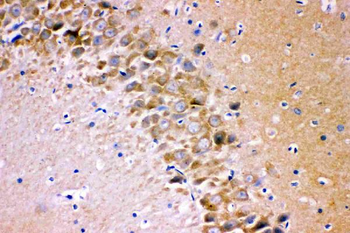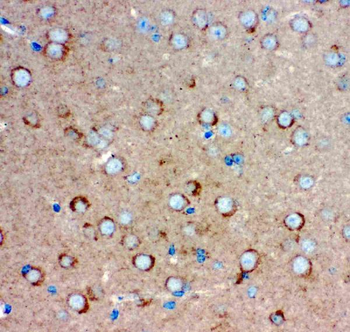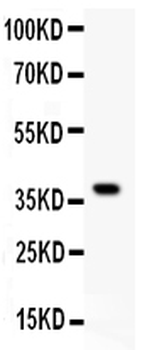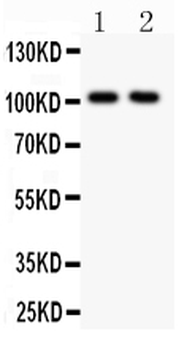You have no items in your shopping cart.
Anti-Glutamate Receptor 1/GRIA1 Antibody
Catalog Number: orb215958
| Catalog Number | orb215958 |
|---|---|
| Category | Antibodies |
| Description | Anti-Glutamate Receptor 1/GRIA1 Antibody |
| Species/Host | Rabbit |
| Clonality | Polyclonal |
| Tested applications | IHC, WB |
| Reactivity | Human, Mouse, Rat |
| Isotype | Rabbit IgG |
| Immunogen | E.coli-derived human GRIA1 recombinant protein (Position: A19-R360). Human GRIA1 shares 98% amino acid (aa) sequence identity with both mouse and rat GRIA1. |
| Antibody Type | Primary Antibody |
| Concentration | Adding 0.2 ml of distilled water will yield a concentration of 500 μg/ml. |
| Form/Appearance | Lyophilized |
| Conjugation | Unconjugated |
| MW | 101 kDa |
| UniProt ID | P42261 |
| Storage | Maintain refrigerated at 2-8°C for up to 2 weeks. For long term storage store at -20°C in small aliquots to prevent freeze-thaw cycles. |
| Alternative names | Glutamate receptor 1; GluR-1; AMPA-selective gluta Read more... |
| Note | For research use only |
| Application notes | Immunohistochemistry (Paraffin-embedded Section), 0.5-1μg/ml, Human, Mouse, RatWestern blot, 0.1-0.5μg/ml, Human, Mouse, Rat. Add 0.2ml of distilled water will yield a concentration of 500ug/ml |
| Expiration Date | 12 months from date of receipt. |

IHC analysis of GRIA1 using anti-GRIA1 antibody. GRIA1 was detected in paraffin-embedded section of Human Meningeoma Tissue. Heat mediated antigen retrieval was performed in citrate buffer (pH6, epitope retrieval solution) for 20 mins. The tissue section was blocked with 10% goat serum. The tissue section was then incubated with 1 µg/ml rabbit anti-GRIA1 Antibody overnight at 4°C. Biotinylated goat anti-rabbit IgG was used as secondary antibody and incubated for 30 minutes at 37°C. The tissue section was developed using Strepavidin-Biotin-Complex (SABC) with DAB as the chromogen.

IHC analysis of GRIA1 using anti-GRIA1 antibody. GRIA1 was detected in paraffin-embedded section of Mouse Brain Tissue. Heat mediated antigen retrieval was performed in citrate buffer (pH6, epitope retrieval solution) for 20 mins. The tissue section was blocked with 10% goat serum. The tissue section was then incubated with 1 µg/ml rabbit anti-GRIA1 Antibody overnight at 4°C. Biotinylated goat anti-rabbit IgG was used as secondary antibody and incubated for 30 minutes at 37°C. The tissue section was developed using Strepavidin-Biotin-Complex (SABC) with DAB as the chromogen.

IHC analysis of GRIA1 using anti-GRIA1 antibody. GRIA1 was detected in paraffin-embedded section of Rat Brain Tissue. Heat mediated antigen retrieval was performed in citrate buffer (pH6, epitope retrieval solution) for 20 mins. The tissue section was blocked with 10% goat serum. The tissue section was then incubated with 1 µg/ml rabbit anti-GRIA1 Antibody overnight at 4°C. Biotinylated goat anti-rabbit IgG was used as secondary antibody and incubated for 30 minutes at 37°C. The tissue section was developed using Strepavidin-Biotin-Complex (SABC) with DAB as the chromogen.

Western blot analysis of GRIA1 using anti-GRIA1 antibody. Electrophoresis was performed on a 5-20% SDS-PAGE gel at 70V (Stacking gel) / 90V (Resolving gel) for 2-3 hours. lane 1: Recombinant Human GRIA1 Protein 0.5 ng. After Electrophoresis, proteins were transferred to a Nitrocellulose membrane at 150mA for 50-90 minutes. Blocked the membrane with 5% Non-fat Milk/ TBS for 1.5 hour at RT. The membrane was incubated with rabbit anti-GRIA1 antigen affinity purified polyclonal antibody at 0.5 µg/mL overnight at 4°C, then washed with TBS-0.1% Tween 3 times with 5 minutes each and probed with a goat anti-rabbit IgG-HRP secondary antibody at a dilution of 1:10000 for 1.5 hour at RT. The signal is developed using an Enhanced Chemiluminescent detection (ECL) kit with Tanon 5200 system. A specific band was detected for GRIA1 at approximately 40 KD. The expected band size for GRIA1 is at 40 KD.

Western blot analysis of GRIA1 using anti-GRIA1 antibody. Electrophoresis was performed on a 5-20% SDS-PAGE gel at 70V (Stacking gel) / 90V (Resolving gel) for 2-3 hours. The sample well of each lane was loaded with 50 ug of sample under reducing conditions. Lane 1: Rat Brain Tissue Lysate, Lane 2: Mouse Brain Tissue Lysate. After Electrophoresis, proteins were transferred to a Nitrocellulose membrane at 150mA for 50-90 minutes. Blocked the membrane with 5% Non-fat Milk/ TBS for 1.5 hour at RT. The membrane was incubated with rabbit anti-GRIA1 antigen affinity purified polyclonal antibody at 0.5 µg/mL overnight at 4°C, then washed with TBS-0.1% Tween 3 times with 5 minutes each and probed with a goat anti-rabbit IgG-HRP secondary antibody at a dilution of 1:10000 for 1.5 hour at RT. The signal is developed using an Enhanced Chemiluminescent detection (ECL) kit with Tanon 5200 system. A specific band was detected for GRIA1 at approximately 101 KD. The expected band size for GRIA1 is at 101 KD.
Anti-Glutamate Receptor 1/GRIA1 Antibody [orb2623073]
IHC, WB
Human, Mouse, Rat
Rabbit
Polyclonal
iFluor647
100 μgAnti-Glutamate Receptor 1/GRIA1 Antibody [orb2623074]
IHC, WB
Human, Mouse, Rat
Rabbit
Polyclonal
PE
100 μgAnti-Glutamate Receptor 1/GRIA1 Antibody [orb2623075]
IHC, WB
Human, Mouse, Rat
Rabbit
Polyclonal
APC
100 μgAnti-Glutamate Receptor 1/GRIA1 Antibody [orb2623076]
IHC, WB
Human, Mouse, Rat
Rabbit
Polyclonal
HRP
100 μgAnti-Glutamate Receptor 1/GRIA1 Antibody [orb2623077]
IHC, WB
Human, Mouse, Rat
Rabbit
Polyclonal
FITC
100 μg



